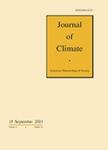版权所有:内蒙古大学图书馆 技术提供:维普资讯• 智图
内蒙古自治区呼和浩特市赛罕区大学西街235号 邮编: 010021

作者机构:Swiss Fed Inst Technol Dept Earth Sci Zurich Switzerland CALTECH 1200 E Calif Blvd Pasadena CA 91125 USA
出 版 物:《JOURNAL OF CLIMATE》 (气候杂志)
年 卷 期:2016年第29卷第16期
页 面:5821-5835页
核心收录:
学科分类:07[理学] 070601[理学-气象学] 0706[理学-大气科学]
基 金:Swiss National Science Foundation [200021-156109] Swiss National Science Foundation (SNF) [200021_156109] Funding Source: Swiss National Science Foundation (SNF)
主 题:Physical Meteorology and Climatology Climate sensitivity Cloud radiative effects Observational techniques and algorithms Satellite observations Mathematical and statistical techniques Spectral analysis/models/distribution Models and modeling Climate models
摘 要:Physical uncertainties in global-warming projections are dominated by uncertainties about how the fraction of incoming shortwave radiation that clouds reflect will change as greenhouse gas concentrations rise. Differences in the shortwave reflection by low clouds over tropical oceans alone account for more than half of the variance of the equilibrium climate sensitivity (ECS) among climate models, which ranges from 2.1 to 4.7 K. Space-based measurements now provide an opportunity to assess how well models reproduce temporal variations of this shortwave reflection on seasonal to interannual time scales. Here such space-based measurements are used to show that shortwave reflection by low clouds over tropical oceans decreases robustly when the underlying surface warms, for example, by -(0.96 +/- 0.22)% K-1 (90% confidence level) for de-seasonalized variations. Additionally, the temporal covariance of low-cloud reflection with temperature in historical simulations with current climate models correlates strongly (r = -0.67) with the models ECS. Therefore, measurements of temporal low-cloud variations can be used to constrain ECS estimates based on climate models. An information-theoretic weighting of climate models by how well they reproduce the measured deseasonalized covariance of shortwave cloud reflection with temperature yields a most likely ECS estimate around 4.0 K;an ECS below 2.3K becomes very unlikely (90% confidence).